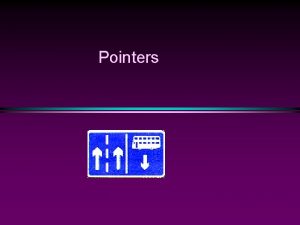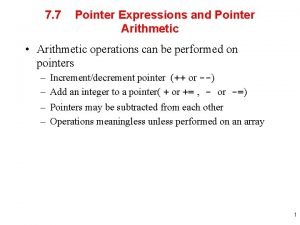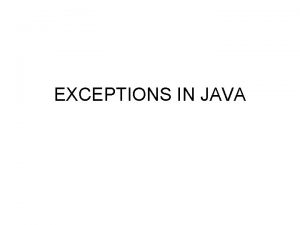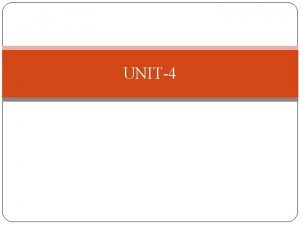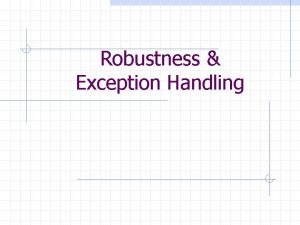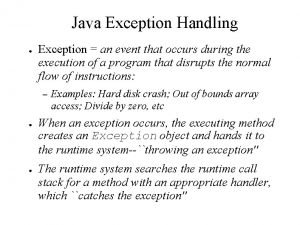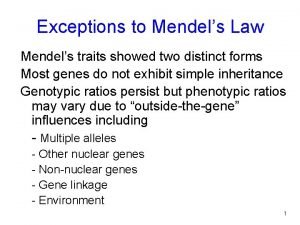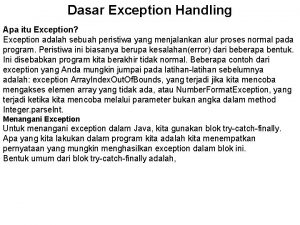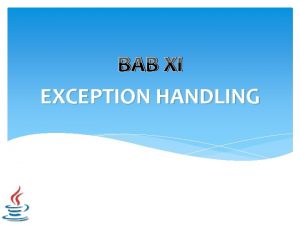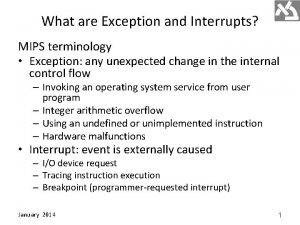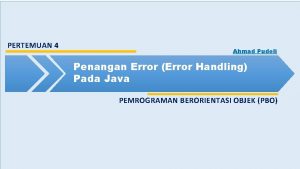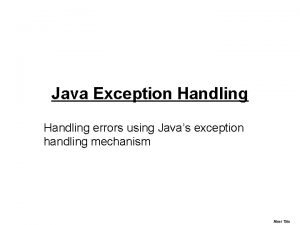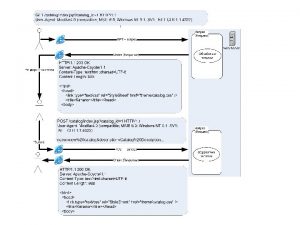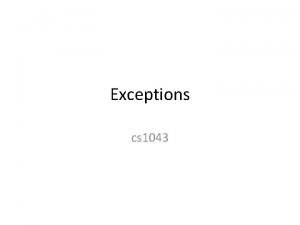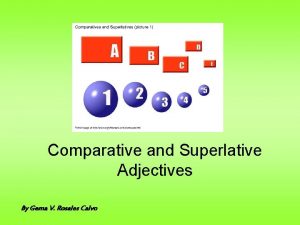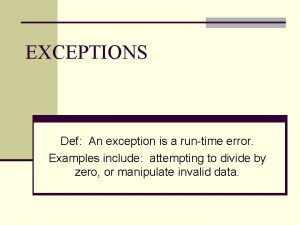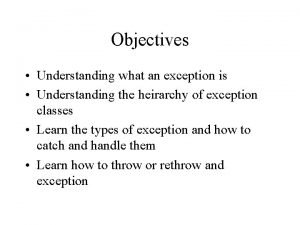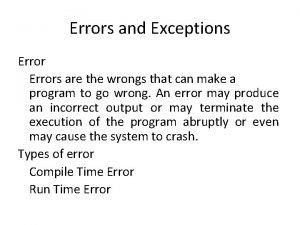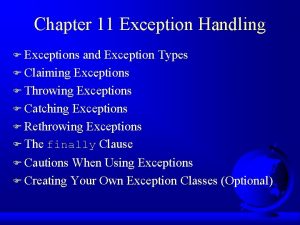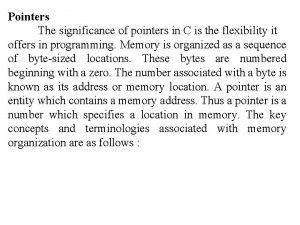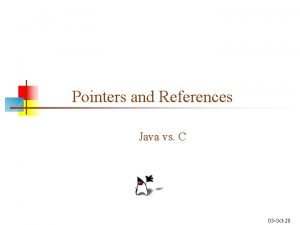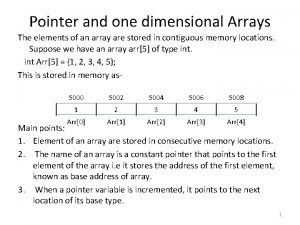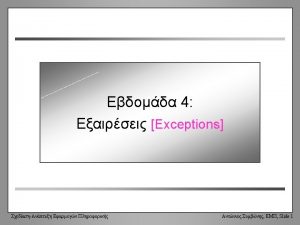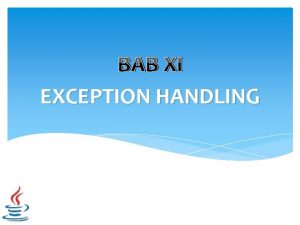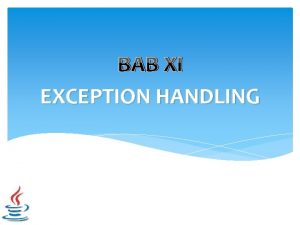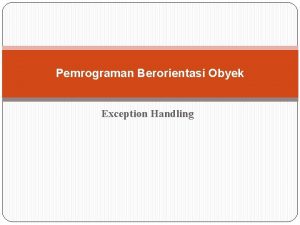Review Why a Null Pointer Exception class Floor








































































![Using the Comparator // Example: sort an array of students Student [ ] students Using the Comparator // Example: sort an array of students Student [ ] students](https://slidetodoc.com/presentation_image/c0fc7b82ce01deb0e83cc4a8c60f475a/image-73.jpg)
![How to create using anonymous class Student [ ] students = Registrar. get. Students( How to create using anonymous class Student [ ] students = Registrar. get. Students(](https://slidetodoc.com/presentation_image/c0fc7b82ce01deb0e83cc4a8c60f475a/image-74.jpg)








- Slides: 82

Review

Why a Null. Pointer. Exception? class Floor. View implements Observer { private Elevator elevator; // the subject private JLabel label; public Floor. View(Elevator elev) { Elevator elevator = elev; JLabel label = new JLabel( "Floor "+elev. get. Floor() ); . . . } public void update(Observable obj, Object arg) { int floor = elevator. get. Floor( ); Null. Pointer. Exception label. set. Text( "Floor "+floor ); Null. Pointer. Exception }

What is a URL? URL = Uniform Resource Locator http: //www. google. com ftp: //se. cpe. ku. ac. th/download/readme. html file: ///C: /temp/somefile. txt Even more complex URLs are possible: jdbc: mysql: //se. cpe. ku. ac. th: 3306/world

How do you read a URL? Java has a URL class. You can create an Input. Stream to read or write to/from a URL url = new URL( "http: //www. google. com/" ); Input. Stream instream = url. open. Stream( ); // process input data as you like Scanner scanner = new Scanner( instream ); while ( scanner. has. Next. Line() ) {. . . }

How do you create a Color? What do these numbers mean? Color purple = new Color(212, 0, 228); What do these numbers mean? red = Color. get. HSBColor(0. 0, 1. 0, 0. 5);

Color Space You can specify any color using 3 numbers. RGB - color given by level of red, green, and blue. Usually 8 -bits (0 -255) per color. Some digital cameras use 12 -bits per color. CMY - cyan, magenta, yellow HSB - Hue, Saturation, Brightness (Java: float 0. 0 -1. 0) HSL - Hue, Saturation, Luminescence

Calculate the Picture Size A digital camera has resolution 4 Megapixels and 8 -bit color depth. 1. How much space to store a photo in TIFF format (no compression)? 2. How much space to store a photo in JPEG format with 10 -to-1 compression?

What is a JAR file? 1. What is the format of a JAR file? 2. How do you create a JAR file? Java reads information from a JAR file, such as the name of the "main" class, whether this JAR is a Java. Bean. 3. What file contains this info?

Getting a Reference The Button. Panel for the elevator needs to send messages to the elevator. q How can we give Button. Panel a reference to the Elevator? q

Solution: inject a Reference This is dependency injection. class Button. Panel extends JFrame { private Elevator elevator; public Button. Panel(Elevator lift) { this. elevator = lift; // dependency. . . }

Dependency Injection by setter method Use a "set" method for dependency injection. class Button. Panel extends JFrame { private Elevator elevator; public Button. Panel( ) {. . . } public void set. Elevator(Elevator lift) { this. elevator = lift; // dependency. . . }

Wrong Solution Create the Elevator in the View. class Button. Panel extends JFrame { private Elevator elevator; public Button. Panel( ) { elevator = new Elevator( ); . . . } // wrong

Draw a Sequence Diagram of Dependency Injection. class Main { public void init( ) { Elevator elevator = new Elevator( ); Button. Panel bp = new Button. Panel( ); bp. set. Elevator( elevator ); elevator. add. Observer( bp ); }

Start Chart Diagram Floor 2 UP DOWN Floor 1 entry/open. Door exit/close. Door

3 Fundamental O-O Characteristics 1. Encapsulation 2. Polymorphism 3. Inheritance

" e p What is Polymorphism? q Define polymorphism. o D " q t ' n k s A t a h Ty W Give the simplest example of polymorphism you can think of (no elevators or observers). Object o = new Coin( 5 ); System. out. println( o. to. String() ); o = new Date( ); System. out. println( o. to. String() );

2 ways to enable Polymorphism? q Name 2 constructs (ways of programming in Java) we can use to achieve polymorphism? 1. inheritance 2. interface q List coins = new My. List(); Give example of each one. 1. Coin is a subclass of Money q How can we enable polymorphism in our apps?

Notifying Observers The Floor. View must update the display whenever the elevator changes state. How is this done? 1. ________ invokes ________ 2. ________ invokes ________ 3. ______ (Observer) calls ________ 4. ________ calls ________

Notifying Observers The Floor. View must update the display whenever the elevator changes state. How is this done? 1. Elevator invokes notify. Observers_ 2. notify. Observers() invokes observer. update( ) 3. Floor. View (Observer) calls elevator. get. Floor() 4. Floor. View calls label. set. Text( "Floor "+floor )

Notifying Observers The Floor. View must update when the Elevator moves. How is this done? Draw and number the method calls.

O-O Fundamentals How are the fundamental O-O characteristics used in the Observer pattern? How does this benefit the program?

Views and Controls Views are Observers. They get notified by Subject. Q: Do views need a reference to Subject? View 2. wake up! (Observer) 3. what happened? 4. update display Floor 5 Abstract Subject 1. notify observers Subject

Views and Controls send messages to the Subject. Q: Do controls need a reference to the Subject? UP BUTTON Abstract Subject 1. event occurs Control 2. handle this 4. notify observers Subject 3. do something

Elevator Views and Controls q Some components are both observer and control. Notification Path Control Path

Remote Control problem We have a 4 -button Remote Control. Design a solution to program the Remote Control. Goals: 1. Don't couple Remote Control to a Light. Bulb or any other device. 2. Can program Remote. Control to control anything. 1 2 3 4

Remote Control solution We have a 4 -button Remote Control. Design a solution to program the Remote Control. 1 2 3 4 click

Use Commands for Remote. Control

How to Program using an Action class On. Action extends Abstract. Action { private Light. Bulb light; public On. Action(Light. Bulb light) { super("Light On"); this. light = light; } public void action. Performed( ) { light. turn. On( ); } }

How to Program using an Action (2) Now you can put the action in as many components as you want. Action on = new On. Action( ); JButton on. Button = new JButton( on ); Menu. Item mitem = new Menu. Item( on ); menu. add. Item( mitem ); Components will get their name, status, icon from the action. They use On. Action as Action. Listener.

How to Program using an Action (3) You can disable the components by disabling the action. set. Enabled( false ); Disable all components using this action.

3 O-O Characteristics q q How does the Command Pattern (using Actions) use the 3 O-O characteristics? What is the benefit of each one?

How does Remote Control use the Pattern? Complete the table. Name in Command Pattern Invoker Command Concrete. Command Receiver execute( ) Name in Application

Abstract Superclass q What is an Abstract Class? a class with one or more abstract methods (method without an implementation) class must be declared "abstract" you cannot create an instance of an abstract class q Give example of an Abstract Class is Java. Abstract. Action, Abstract. List, Observable q Why use an Abstract Class? see following slides

Abstract Class q How would you use an Abstract Class?

Abstract Class for Money q Factor out common behavior and attributes needed by subclasses

Abstract Class for Money q Provide default implementations for methods if you don't like my equals then do it yourself! @Override equals(Object) {. . . }

Mouse. Adapter Abstract class provides default implementations of methods (convenience). Most of them do nothing. q Makes it easier to implement the interface. q

Abstract Classes Provide Behavior Observable, Abstract. List, Abstract. Action Abstract superclass providing methods and attributes that implement useful behavior. Subclass can reuse this functionality or override it. Abstract. Action provides useful behavior to its subclasses.

Benefits of Abstract Superclass 1. 2. 3.

Disadvantage of Abstract Superclass Are there any disadvantages or limitations on using an Abstract Superclass? 1. 2.

Abstract Superclass or Interface? Compare Abstract Class with Interface. Abstract Superclass Interface

Patterns

What Pattern Should We Use? q q General Problem: some resource needs to be shared by all objects. How can we guarantee that only one instance exists? Example: share a connection to a database. // Database. Manager should ensure we always // use the same connection Connection connection = Database. Manager. get. Connection( );

Draw a Class Diagram of Solution

Changing Some Behavior q q General Problem: we have a reusable class but some methods need to change their behavior (algorithm) in different situations. Example: change the way a Container arranges Components. panel. set. Layout( new Grid. Layout(4, 3) ); panel. add( button 1 ); panel. add( button 2 ); . . .

Draw a Class Diagram Draw a class diagram of the parts of the Strategy Pattern

Complete the Table How do Container and Layout. Manager use this pattern? Complete this table. Name in Strategy Pattern Context Strategy Concrete. Strategy set. Strategy( ) do. Work( ) Name in this application

Give Another Example Give another example of the Strategy Pattern.

What Pattern Should We Use? General Problem: we want to modify or enhance some behavior of a class, but we don't want to modify the class. q Example: how to add scroll bars to components q JText. Area textarea = new JText. Area( 8, 40); JScroll. Pane pane = new JScroll. Pane( textarea ); pane. set. Vertical. Scrollbar. Policy( JScroll. Pane. VERTICAL_SCROLLBAR_AS_NEEDED ): // add pane (not textarea) to container contentpane. add( pane );

Class Diagram of Decorator q Draw a class diagram of the decorator pattern.

Give Example of Observer Pattern Name in Observer Pattern Observer Subject (Observable) add. Observer( ) upate( ) [in Observer class] Name in Application

What Pattern Should We Use? General Problem: we have some legacy (existing) class we want to use, but it doesn't have the correct interface. q Example: The Vector class creates an Enumeration (old), but our application wants an Iterator. q Enumeration<String> en = vector. elements( ); // process all the elements while ( en. has. More. Elements() ) { String s = en. next. Element( ); }

Draw a Class Diagram of Solution Design an Enumeration. Adapter<T> that implements Iterator<T>.

Being Adaptive q Problem: We want to put a Bank. Account object in the Purse. But Bank. Account doesn't implement the Valuable interface. We don't want to change the Bank. Account class, either. Adapter get. Value()

Bank. Account. Adapter class Bank. Account. Adapter implements Valuable { private Bank. Account account; // dependency injection public Bank. Account. Adapter( Bank. Account acct ) { this. account = acct; } public int get. Value() { return account. get. Balance(); } }

Give Example of Observer Pattern Name in Observer Pattern Observer Subject (Observable) add. Observer( ) upate( ) [in Observer class] Name in Application

Improving Your Development Skills

Improving Your Development Skills 1. Set Goals. 2. Be curious. What do you want to do? 3. Study good examples. n Apache Jakarta projects n Source. Forge projects (some good, some bad) n Object. Web. com, Java. Lobby, MSDN, . . . n many others 4. Practice, practice. n With discipline. . . design first, record your results. n Personal solutions log, blog, or wiki.

Improving Your Development Skills 5. Read.

What We Didn't Cover 1. Frameworks. A structure for building applications. 2. Libraries. Reusable software components. 2. Design principles and design patterns. n Gamma, et al. Patterns of Reusable Software n Head First books

Additional Review

Student (sorry this is so boring( q Implement the Student class described at right. q Use the appropriate visibility for all members (attributes and methods). q Compare students by id q Write a to. String that can be used to produce output like this: q [48541111] Bill Gates <<interface>> T Comparable compare. To( other ) <T: : Student> Student id firstname lastname Student( first, last, id ) Student( first, last ) compare. To( student ) to. String( )

Write a Student. Reader class Purpose: reads student data from an Input. Stream. q Each line of data contains: student_id firstname 48541111 Bill Gates lastname Provides an Iterator<Student> to return one student object for each line of data read. Questions: 1. what methods does an Iterator have? 2. how do you show this in UML? 3. why use an Input. Stream? Why not a File? q

Student. Reader q <<interface>> Write the code T Iterator +has. Next( ) : boolean + next( ) : T + remove( ) <T: : Student> Student - id - firstname - lastname Student( first, last, id ) compare. To( s ) "has a" Student. Reader( Input. Stream )

Draw a Sequence Diagram int sumdata( ) { // data should be a parameter, but for simplicity. . . String data = new String( "3 5 8 13" ); Scanner in = new Scanner( data ); int sum = 0; while ( in. has. Next. Int( ) ) { int n = in. next. Int( ); sum += n; } return sum; }

Draw a Sequence Diagram public void run( ) { Coupon. Calc calc = new My. Coupon. Calc( ); Coupon. UI ui = new Coupon. UI( calc ); ui. run( ); }

Coupon Assistant q Why not design Coupon Assistant like this? Coupon. UI My. Coupon. Calc - calc : My. Coupon. Calc + My. Coupon. Calc( ) public Coupon. UI( ) { calc = new My. Coupon. Calc( ); } public static void main(. . . ) { ui = new Coupon. UI( ); ui. run( );

What does this diagram mean? Why did we design the Coupon Assistant like this? q What is the benefit of this? q Coupon. UI - calc : Coupon. Calc <<interface>> Coupon. Calc methods + run( ) Main main( ); calc = new My. Coupon. Calc( ); ui = new Coupon. UI( calc ); ui. run( ); My. Coupon. Calc + My. Coupon. Calc( )

JOption. Pane What is show. Confirm. Dialog ? Is it a static or instance method? What is JOption. Pane. NO_OPTION int choice; choice = JOption. Pane. show. Confirm. Dialog( null, "Are you awake? ", "This is a Confirm Dialog", JOption. Pane. YES_NO_CANCEL_OPTION ); if ( choice == JOption. Pane. NO_OPTION ) JOption. Pane. show. Message. Dialog( null, "Liar!!");

Magic Numbers Is there any problem with this code? int choice; choice = JOption. Pane. show. Confirm. Dialog( null, "Do you really want to quit? ", "Confirm Quit", JOption. Pane. OK_CANCEL_OPTION ); if ( choice == 0 ) System. exit( 0 ); How would you improve it?

Comparator Arrays. sort can accept a 2 nd parameter: Arrays. sort( array, comparator ) array to sort will call comparator. compare(a, b) <<interface>> Comparator Why is this useful? Is compare( ) an instance or static method? +compare( a: T, b: T ) +equals( other ) T

Sort Students by First Name q. Write a Comparator that sorts students by first name. q. We can't use "Student. compare. To" because it already sorts Students by ID. /** Define a comparator for ordering students by first name */ public class Student. Comparator implements Comparator<Student> { int compare( Student a, Student b ) { // return + if after b, - if a before b, 0 if a and b have same order return a. get. First. Name( ). compare. To. Ignore. Case( b. get. First. Name() ); } }
![Using the Comparator Example sort an array of students Student students Using the Comparator // Example: sort an array of students Student [ ] students](https://slidetodoc.com/presentation_image/c0fc7b82ce01deb0e83cc4a8c60f475a/image-73.jpg)
Using the Comparator // Example: sort an array of students Student [ ] students = Registrar. get. Students( ); Comparator<Student> comp = new Student. Comparator(); Arrays. sort( students, comp ); /** Define a comparator for comparing students by first name */ public class Student. Comparator implements Comparator<Student> { int compare( Student a, Student b ) { // return + if after b, - if a before b, 0 if a and b have same order return a. get. First. Name( ). compare. To. Ignore. Case( b. get. First. Name() ); } }
![How to create using anonymous class Student students Registrar get Students How to create using anonymous class Student [ ] students = Registrar. get. Students(](https://slidetodoc.com/presentation_image/c0fc7b82ce01deb0e83cc4a8c60f475a/image-74.jpg)
How to create using anonymous class Student [ ] students = Registrar. get. Students( ); Comparator<Student> comp = new Comparator<Student>( ) { // anonymous class definition for a Comparator<Student> object int compare( Student a, Student b ) { // return + if after b, - if a before b, 0 if a and b have same order return a. get. First. Name( ). compare. To. Ignore. Case( b. get. First. Name() ); } } ; // end of anonymous class and end of assignment ( ; ) Arrays. sort( students, comp );

Comparator Factory Method q. Create a static method in the Student class that creates the comparator object (previous slide) using an anonymous class. q. Named the method get. Student. Name. Comparator( ) public class Student implements Comparable<Student> {. . . public static Comparator<Student> get. Student. Name. Comparator ( ) { return new Comparator<Student>( ) { public int compare. To( Student a, Student b ) { return a. get. First. Name(). compare. To( b. get. First. Name() ); } }; // end of the statement } // end of the method

Designing Classes Choose responsibilities and attributes. q Design the public "interface" of the class. q Guides for class design: n cohesion - should be high n coupling to other classes - lower is better q Guides for interface: n completeness n convenience n clarity n consistency q

Big. Decimal Arithmetic q Write an average( ) method that computes the average of an array of Big. Decimal objects. public Big. Decimal average( Big. Decimal [ ] x ) { Big. Decimal sum = new Big. Decimal( 0. 0 ); for( Big. Decimal value : x ) sum = sum. add(value); return sum. divide( new Big. Decimal( x. length ) ); }

Big. Decimal Arithmetic q Write a max( ) method that returns the maximum value in an array of Big. Decimal objects, using only the compare. To method -- don't use Big. Decimal. max( ). public Big. Decimal max( Big. Decimal [ ] x ) { Big. Decimal max = x[0]; //. . . find the max in x[*] for( int k=1; k < x. length ; k++ ) //if ( x[k] > max ) max = x[k]; if ( x[k]. compare. To(max) > 0 ) max = x[k]; return max; }

Big. Decimal More Arithmetic Write a static sqrt( ) method for Big. Decimal objects using Euler's method of finding square roots. q Find sqrt(2) accurate to 100 decimal places. q Let y = the value you want the square root of tolerance = allowed error in the answer Algorithm: This is useful practice for how to use method calls, but it throws a runtime x = 1. 0; // initial guess exception because some values repeat { have infinitely long decimal form. x 0 = x; You must use another form of Big. Decimal methods that has a x = ( x + y/x ) / 2; remainder. } until ( | x - x 0 | <= tolerance ) x is approximately the square root of y.

How to Write a Clone Method q Clone the Student class (next slide(

Deep copy of student public class Student implements Cloneable, Comparable { private String id; private Date birthday; // date is mutable private List<Course> courses; public Object clone() { //1. make a new clone object and clone superclasses Student clone = (Student) super. clone( ); //2. copy all the atrributes to the clone. id = new String( this. id ); clone. birthday = this. birthday. clone(); clone. courses = new Array. List<Course>( ); for( course: this. courses ) clone. courses. add( course. clone() ); //3. return the clone return clone; }

Variable Scope and try - catch int a = in. next. Int( ); int b = in. next. Int( ); try { int c = a / b; } catch ( Exception e) { System. err. println("bad division"); } System. out. println("a / b = " + c );
 Constant pointer and pointer to constant
Constant pointer and pointer to constant What is pointer to pointer in c
What is pointer to pointer in c 9 pointers
9 pointers Constant to pointer in c
Constant to pointer in c Display the address of intval using cout and intptr.
Display the address of intval using cout and intptr. Pointer expressions
Pointer expressions Pointer pointer
Pointer pointer Pointer pointer
Pointer pointer Hey bye bye
Hey bye bye Interface foo
Interface foo Class a void foo() throws exception
Class a void foo() throws exception Exception class hierarchy in java
Exception class hierarchy in java Class not found exception
Class not found exception Don't ask why why why
Don't ask why why why Hierarchy of thread class in java
Hierarchy of thread class in java Innerexception: system.io.directorynotfoundexception
Innerexception: system.io.directorynotfoundexception Robust programs
Robust programs Php exception example
Php exception example Unt pcard exception form
Unt pcard exception form Exception of koch postulates
Exception of koch postulates Runtimeexception extends exception
Runtimeexception extends exception What is exception
What is exception Exception vs error in java
Exception vs error in java Exception handling pl sql
Exception handling pl sql Mendel's law exceptions
Mendel's law exceptions Vb net error handling
Vb net error handling Exception handling in java
Exception handling in java Charting by exception pros and cons
Charting by exception pros and cons Exception adalah
Exception adalah Exception of koch postulates
Exception of koch postulates Apa itu exception
Apa itu exception Goodsall rule exception
Goodsall rule exception Epc register mips
Epc register mips Usfws designated ports
Usfws designated ports Dbs311 assignment 2
Dbs311 assignment 2 Exception handling pada java
Exception handling pada java Vb.net nvl
Vb.net nvl Model dokumentasi pie
Model dokumentasi pie Java exception error
Java exception error Arm exception handling
Arm exception handling Http data source exception
Http data source exception Exception handling in ada
Exception handling in ada Liraglutide ramq
Liraglutide ramq Php global exception handler
Php global exception handler What is exception in computer architecture
What is exception in computer architecture A programmer can choose to ignore an unchecked exception.
A programmer can choose to ignore an unchecked exception. Apa yang dimaksud dengan exception
Apa yang dimaksud dengan exception Exception
Exception Bad en superlative
Bad en superlative Ceg exception
Ceg exception Tceq exception request
Tceq exception request What exception if any permits a private pilot
What exception if any permits a private pilot What is a friend class
What is a friend class Explain fajans rule
Explain fajans rule Fajans rules
Fajans rules Year 2 spellings
Year 2 spellings Invoice exception
Invoice exception An exception is a runtime error
An exception is a runtime error Vb net error handling
Vb net error handling Data migration strategiesê
Data migration strategiesê Pemrograman berorientasi objek
Pemrograman berorientasi objek Java unchecked exception
Java unchecked exception Java exception localized message
Java exception localized message Java unchecked exception
Java unchecked exception A____block enclose the code that could throw an exception.
A____block enclose the code that could throw an exception. 작업스케줄러 컴퓨터 종료
작업스케줄러 컴퓨터 종료 R throw exception
R throw exception Chapter review motion part a vocabulary review answer key
Chapter review motion part a vocabulary review answer key Ap gov review final exam review
Ap gov review final exam review Nader amin-salehi
Nader amin-salehi Inclusion criteria examples
Inclusion criteria examples Narrative review vs systematic review
Narrative review vs systematic review Gruppefordeling
Gruppefordeling Stack grows downwards
Stack grows downwards One full revolution of the pointer on the dial equals
One full revolution of the pointer on the dial equals Importance of pointers
Importance of pointers Pointer in java
Pointer in java Dangling pointer in c
Dangling pointer in c Pointer and one dimensional array
Pointer and one dimensional array Inter pointer
Inter pointer Pointer in memory
Pointer in memory Skip pointers
Skip pointers For skip pointer more skip leads to
For skip pointer more skip leads to
